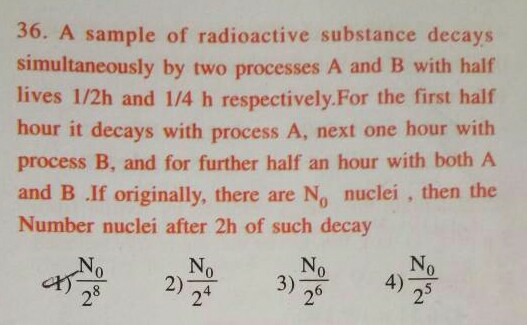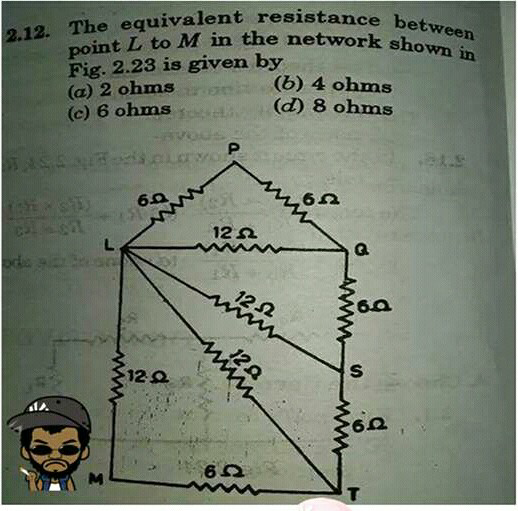
Question and Answers Forum
OthersQuestion and Answers: Page 142






Pg 137 Pg 138 Pg 139 Pg 140 Pg 141 Pg 142 Pg 143 Pg 144 Pg 145 Pg 146
|
Question and Answers Forum |
OthersQuestion and Answers: Page 142 |
| A body in a uniform horizontal circular motion possesses a variable velocity. Does it mean that the K.E. of the body is also variable? |
| A body of mass m is projected with a speed v making an angle θ with the vertical. What is the change in momentum of the body along the Y- axis; between the starting point and the highest point of its path? |
| In long jump, does it matter how high you jump? What factors determine the span of the jump? |
| A projectile is fired at an angle θ with the horizontal direction from O. Neglecting the air friction, it hits the ground at B after 3 seconds. What is the height of point A from ground? [Use g = 10 m/s^2 ] |
| Path of the bomb released from an aeroplane moving with uniform velocity at certain height as observed by the pilot is (a) a straight line (b) a parabola (c) a circle (d) none of the above |
| How many nodal planes are present in 4d_z^2 ? |
| For 2s orbital Ψ_r = (1/(√8))((z/a_0 ))^(3/2) (2 − ((zr)/a_0 ))e^(−((zr)/(2a_0 ))) then, hydrogen radial node will be at the distance of (1) a_0 (2) 2a_0 (3) (a_0 /2) (4) (a_0 /3) |
| Photoelectric emission is observed from a surface when lights of frequency n_1 and n_2 incident. If the ratio of maximum kinetic energy in two cases is K : 1 then (Assume n_1 > n_2 ) threshold frequency is (1) (K − 1) × (Kn_2 − n_1 ) (2) ((Kn_1 − n_2 )/(1 − K)) (3) ((K − 1)/(Kn_1 − n_2 )) (4) ((Kn_2 − n_1 )/(K − 1)) |
| An electron is moving in 3^(rd) orbit of Hydrogen atom. The frequency of moving electron is (1) 2.19 × 10^(14) rps (2) 7.3 × 10^(14) rps (3) 2.44 × 10^(14) rps (4) 7.3 × 10^(10) rps |
| The mathematical expression which is true for the uncertainty principle is (1) (Δx) (Δv) ≥ (h/(4π)) (2) (ΔE) (Δx) ≥ (h/(4π)) (3) (Δθ) (Δφ) ≥ (h/(4π)) (4) (Δx) (Δm) ≥ (h/(4π)) |
| H_α line of Balmer series is 6500 A^o . The wave length of Hγ is (1) 4815 A^o (2) 4298 A^o (3) 7800 A^o (4) 3800 A^o |

|
| A spherical balloon of 21 cm diameter is to be filled with hydrogen at NTP from a cylinder containing the gas at 20 atmosphere at 27°C. If the cylinder can hold 2.82 litres of water, calculate the number of balloons that can be filled up. |
| A particle is projected horizontally with speed u from point A, which is 10 m above the ground. If the particle hits the inclined plane perpendicularly at point B. [g = 10 m/s^2 ] Find horizontal speed with which the particle was projected. |
| An open flask contains air at 27°C. To what temperature it must be heated to expel one-fourth of the air? |

|

|
| prove that (4cos9° − 3)(4cos27° − 3) = tan9° |
| Path of a projectile as seen from another projectile is a (1) Straight line (2) Parabola (3) Ellipse (4) Hyperbola |
| The motion of a particle moving along x-axis is represented by the equation (dv/dt) = 6 − 3v, where v is in m/s and t is in second. If the particle is at rest at t = 0, then (1) The speed of the particle is 2 m/s when the acceleration of particle is zero (2) After a long time the particle moves with a constant velocity of 2 m/s (3) The speed is 0.1 m/s, when the acceleration is half of its initial value (4) The magnitude of final acceleration is 6 m/s^2 |
| A particle is projected from the foot of an inclined plane having inclination 45°, with the velocity u at an angle θ (> 45°) with the horizontal in a vertical plane containing the line of greatest slope through the point of projection. Find the value of tan θ if the particle strikes the plane (i) Horizontally (ii) Normally |

|
| If λ_1 and λ_2 are respectively the wavelengths of the series limit of Lyman and Balmer series of Hydrogen atom, then the wavelength of the first line of the Lyman series of the H-atom is (1) λ_1 − λ_2 (2) (√(λ_1 λ_2 )) (3) ((λ_2 − λ_1 )/(λ_1 λ_2 )) (4) ((λ_1 λ_2 )/(λ_2 − λ_1 )) |

|

|
| A particle is moving along a straight line with uniform acceleration has velocities 7 m/s at P and 17 m/s at Q. If R is the midpoint of PQ, then the average velocity between P and R is? |
Pg 137 Pg 138 Pg 139 Pg 140 Pg 141 Pg 142 Pg 143 Pg 144 Pg 145 Pg 146 |